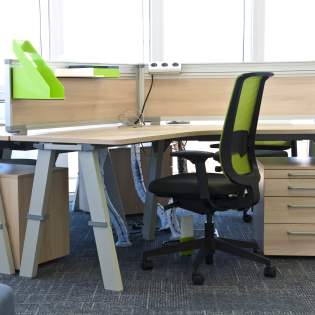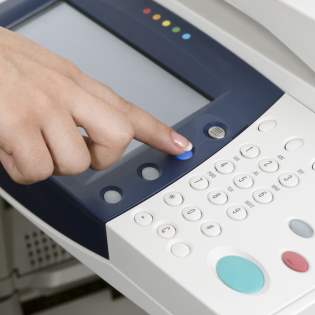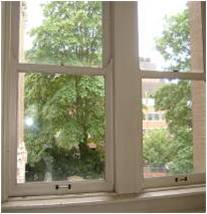Furniture, Fixtures, and Equipment
Follow these sustainable strategies when procuring the movable furniture, fixtures and equipment (FF&E) that have no permanent connection to the structure of a building. Federal projects should meet or exceed the Guiding Principles for Sustainable Federal Buildings. Refer to the Apply Section of SFTool for representative project case studies to discover key practices, benefits, results and checklists.
For sustainable strategies specific to non-office workspaces, such as cafeterias and labs, refer to the Explore Section.
Furniture
- Follow federal environmental and energy guidelines for product and service purchases
- Select products and materials having environmentally preferable attributes as certified by a third party, and locally sourced where possible
- Avoid new furniture that is made with foam cushions that contain polybrominated flame retardants which are suspected of causing cancer
- Select durable furniture products and materials with long warranties to reduce the impact of producing new furniture
- Select products and finishes that are easily cleanable using cleaning products having environmentally preferable attributes as certified by a third party
Fixtures
- Follow federal environmental and energy guidelines for product and service purchases
- Confirm the availability and operational details of recycling and composting infrastructure and include well labeled recycle and compost containers to reduce waste
- Install signage and displays to educate visitors about the organization’s sustainable goals and the sustainable attributes of the space
- Select window treatments having environmentally preferable attributes as certified by a third party, and locally sourced where possible
- Maximize access to daylight and views
- Install dynamic window treatment systems such as automated shades to avoid the negative effects of glare
- Protect Indoor Environmental Quality
- Install entryway systems with recessed grates and/or ‘walk-off’ mats to prevent dirt and debris from entering the space
Equipment
- Follow federal and environmental and energy guidelines for product and service purchases
- Provide mobile phones to reduce the need for cabling, reduce move and churn costs, and support mobile work
- Protect Indoor Environmental Quality
- Centralize and separately ventilate printers and copiers to reduce air quality problems
- Design workspaces to minimize stress and strain on the body
- Ensure all computer equipment components are adjustable
References/Resources
- Acquisition.gov | Federal Acquisition Regulation (FAR) Part 23 - Environment, Energy, and Water Efficiency, Renewable Energy Technologies, Occupational Safety, and Drug-Free Workplace

- Acquisition.gov | Federal Acquisition Regulation (FAR) Part 52 - Solicitation Provisions and Contract Clauses, Subpart 223

Related Topics
Adjustable Equipment
To promote occupant comfort, equipment should be adjustable. This includes ergonomic seating and desks, well-designed cleaning equipment, occupant controlled lighting, and controllable daylight/glare control.
Advanced Power Strip (APS)
Advanced power strips (APS) save energy by controlling the power supplied to plug-in devices during unoccupied periods. A variety of APS technologies exist on the market that vary in complexity, control strategies, data collection abilities, and costs.
Potential barriers for APSs include: occupant acceptance, communications, lack of personnel time for analysis, and complex controls in some instances. These devices may require operations and maintenance to update controls, manage data, and troubleshoot incorrect operations and communication failures on a regular basis.
Explore Plug Load content to discover more.
Building Furnishings
Products used inside buildings, such as furniture, ice and vending machines, and water coolers. Products in this category may also apply to the acquisition of construction services.Daylighting
Daylighting uses natural daylight as a substitute for electrical lighting. While it will likely be counterproductive to eliminate electrical lighting completely, the best proven strategy is to employ layers of light - using daylight for basic ambient light levels while providing occupants with additional lighting options to meet their needs.
An effective daylighting strategy appropriately illuminates the building space without subjecting occupants to glare or major variations in light levels, which can impact comfort and productivity.
In order to provide equitable access to daylight ensure the space is optimized to disperse daylight well. Locate private offices toward the core of the space and specify low workstation panels. Use glass walls and light-colored surfaces on walls and desks to disperse daylight throughout the space. In all daylighting strategies, it is important to consider glare and to take steps to minimize it. Find more strategies below:
GSA | Saving Energy through Lighting and Daylighting Strategies![]()
DOE LBL | Tips for Daylighting with Windows![]()
Durable
Durability of an item or material is its ability to withstand wear, tear, heavy use, and still remain usable. It can refer to many materials, including functional and aesthetic aspects of a project. Choosing durable materials is an important green building strategy. Long lasting materials do not require frequent replacement, which means less demand on new resources and less waste to be recycled or placed in landfills.
Durable Goods
Durable goods have a long useful life (typically two years or more), are replaced infrequently, and typically have a high cost per unit. This is in contrast to ongoing consumables which have a relative low-cost per unit and are replaced frequently. Examples of durable goods include furniture, printers, computers, refrigerators and televisions. Greenhouse gas emissions can be reduced by properly disposing of durable goods at the end of their useful life through re-use programs or recycling. Donate used furniture or electronics to a local program or charity, or find a certified vendor who will responsibly recycle the materials.
Whole Building Design Guide | Life-Cycle Cost Analysis (LCCA)![]()
Whole Building Design Guide | Evaluating and Selecting Green Products![]()
Electronics
Entryway Systems/Walk-off Mats
Toxins are tracked into a building on occupants’ shoes. Entryway systems, like grates, grills, and walk-off mats can greatly reduce the amount of outside dirt, dust, and particulates brought into the building. This makes for a cleaner environment, and cuts down on the amount of cleaning necessary to maintain a high level of cleanliness in the facility.
Finish
A finish is the final covering material in an arrangement of building components. It can refer to the finish on the floor, countertop, wall, or piece of furniture. Similar to adhesives and binders, finishes must also be used with care. They can emit high levels of harmful Volatile Organic Compounds (VOCs), which can be dangerous to human health and the environment. Lower VOC finishes are preferable, and all spaces where finishes are applied should be well ventilated.
South Coast AQMD.gov | Rule 1168: Adhesive and Sealant Applications![]()
GrealSeal.org | Green Seal Standards![]()
Indoor Air Quality (IAQ)
Indoor Air Quality (IAQ) refers to the state of the air within a space. A space with good indoor air quality is one that is low in toxins, contaminants and odors. Good air quality possible when spaces are well ventilated (with outside air) and protected from pollutants brought into the space or by pollutants off-gassed within the space. Strategies used to create good IAQ include bringing in 100% outside air, maintaining appropriate exhaust systems, complying with ASHRAE Standard 62.1, utilizing high efficiency MERV filters in the heating ventilation and air conditioning (HVAC) system, installing walk-off mats at entryways, prohibiting smoking with the space and near operable windows and air intakes, providing indoor plants, and using only low-emitting / non-toxic materials and green housekeeping products.
Information Technology (IT)
The right IT can enable sustainable behaviors. Wireless connectivity and communication tools can support mobility within the office and alternative work arrangements.
Recycling
Recycling is the process of collecting and processing materials (that would otherwise be thrown away as trash) and remanufacturing them into new products. Recycling support stations and the education of occupants and janitorial staff are the backbone of a successful waste diversion plan. Start by confirming with the recycling hauler and compost service what materials are acceptable and the proper collection method. Separate, color-coded, well-labeled and strategically placed recycling containers and waste receptacles make sorting and collection convenient and support occupant participation.
Reuse (Waste)
Similar to recycling, reuse refers to finding new uses for items instead of sending them to landfills. Can furniture be reused in another department of the company? Can electronics be donated to charity? Even using an empty soda bottle to make a hummingbird feeder is a way to reuse items instead of trashing them.
http://consumersunion.org/pdf/ZeroReport.pdf![]()
Solid Waste
Waste comprises all materials that flow from a building to final disposal. Examples include paper, grass trimmings, food scraps, and plastics. Responsible stewardship tries to divert as much waste as possible from the landfill. This can mean recycling paper, mulching or composting grass trimmings, and reusing large items, such as furniture.
EPA | Land, Waste, and Cleanup Topics![]()
Sustainable Purchasing
Purchasing managers should create purchasing plans and programs that give preference to items containing recycled content, certified wood, and rapidly renewable materials, as well as items that are energy efficient, non-toxic, durable and locally manufactured, harvested and / or extracted. Further, purchasing managers should prioritize vendors who promote source reduction through reusable or minimal packaging of products.
Department of Energy | Federal Laws and Requirements Search![]()
Views (to the Outside)
Building occupants with access to outside views have an increased sense of well-being. Keeping employees happy and healthy is good for business, as happy employees show higher productivity and increased job satisfaction, resulting in less employee turnover. In order to provide equitable access to views, it is recommended that private offices are located toward the core of the space and that low workstation panels are installed to allow for maximum daylight penetration. Use glass walls and partitions to enable views out from interior spaces.
Waste Diversion
Waste diversion is the process of diverting waste from the landfill. Waste in landfills and incinerators create greenhouse gas emissions that contribute to climate change. Ways to increase waste diversion include recycling, reusing, and source reduction.



